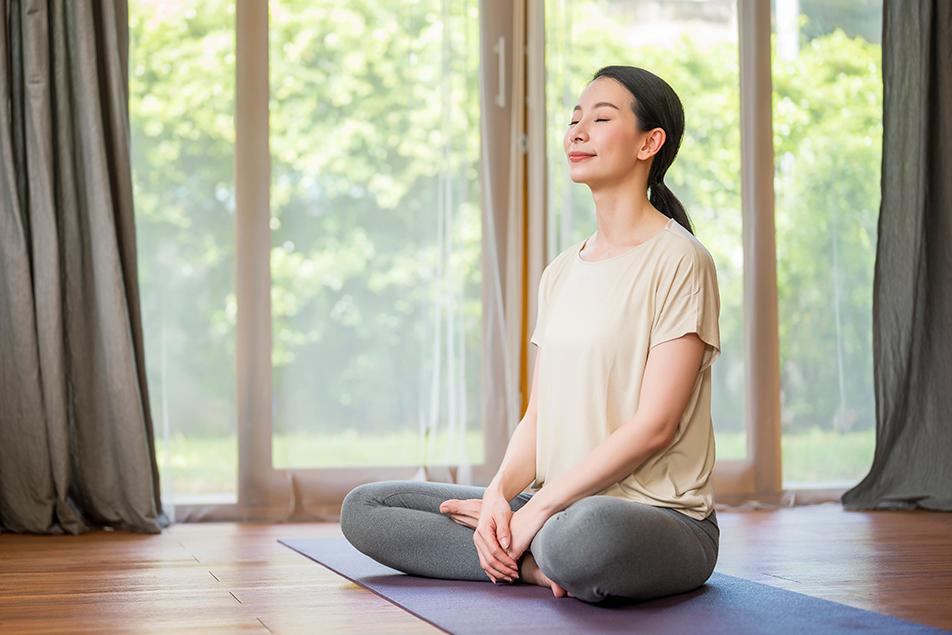
This post was written by Morgan England, youth well-being coach, Parkview Health.
It might surprise you to know that our five senses send 11 million bits of information to the brain for processing every second, but the conscious brain can only process 50 bits per second. With so much information from our senses, families, friends, the media and social media flooding our brains it’s important that we carve out time each day to be still and quiet all the noise. To do that, let’s start with our breathing.
Breathing exercises
One of my favorite breathing exercises is 4-square breathing or box breathing. This is how it works: You will inhale for four seconds, hold that breath for four seconds, exhale completely for four seconds, then be still for four seconds. Repeat as you feel necessary.
I advise creating 2-3 squares. Begin by sitting up nice and tall. Shrug your shoulders up to your ears, then relax them down gently. Then, turn your attention to your jaw and begin to soften those muscles to relax. Finally, close your eyes. Imagine you’re creating squares with your breath. Each square is 4 seconds long.
Now you try it. Inhale, 2, 3, 4. Hold, 2, 3, 4. Exhale, 2, 3, 4., Pause, 2, 3, 4. That’s it.
Let’s talk about stress
Now that we are all nice and calm, let’s talk about stress. Stress is the body’s response to pressures. The goal of these pressures is to protect us and help transform us into our best selves. I know many of you are saying, “Yeah right. Stress might make you better, but it doesn’t make me any better.” Correct, stress typically doesn’t make us any better because we allow it to have a negative presence in our lives, but not all stress is bad. There are good types of stress and a healthy amount that is acceptable and needed in our lives.
Pressures can be internal or external, meaning you have a say in how much stress you put on yourself and how much stress you take off yourself. The first step in managing your stress is identifying what you are stressed about. If you don’t know what’s stressing you out, you’re unable to do anything about it. So, take a minute or two to jot down all the things that are stressful for you right now, then set that list aside, we will use it later.
Now, I want you to think about your symptoms of stress. Symptoms are important because they’re the way your body indicates that something is wrong and can manifest physically, mentally, emotionally or socially. Additionally, many see symptoms of stress as being debilitating, annoying and inconvenient. While stress can put a damper on everyday life and strain relationships, it also lets us change the way we think about our symptoms. We can either intervene and de-stress or allow those stress levels to continue to build.
Once symptoms do arise, I encourage you to acknowledge them, then choose a healthy de-stressing activity or strategy. We’re all living in incredibly stressful and uncertain times right now. It’s easy to jump to unhealthy habits and behaviors. While those habits and behaviors tend to be quick and easy, they’re not effective long term. Unhealthy strategies tend to only serve as a quick fix, distracting you from your feelings of stress and once you stop using them your stress levels will come right back.
Healthy strategies, on the other hand, take effort, energy, and attention and are effective long-term at decreasing your stress. Healthy strategies could include music, breathing, writing, reading, sleeping, talking, taking breaks, nature, exercise, art, bathing, pets, yoga, meditation, cleaning, friends/family, laughter, gratitude, drink water, drink a warm beverage, bake/cook, positive self-talk, giving others compliments and words of affirmation. Let’s take a closer look at a few of my favorites.
Stress management strategies
Movement
Moving your body releases endorphins that improve mood and decrease stress. This can be anything from stretching to walking your dog, running a few miles, shooting hoops, riding your bike, lifting weights or completing an obstacle course. Any time you move your body you’re improving your physical and mental health, allowing yourself to begin processing and working through the different things that are causing you stress.
Mindfulness
Mindfulness is the practice of switching yourself from autopilot to manual. We do this by focusing on a single thing. The reason we stress is that we are continually feeding thoughts to a specific person, place, or thing. Until we interrupt those thoughts, we are unable to calm ourselves down and quiet the mind. When we bring our attention back to something foundational like our breath, we can relax our bodies by lowering our heart rate and blood pressure, as well as quiet all of those thoughts swirling in our heads.
Management
Stress management has two different sides. First and foremost, stress management is reaching out for help when you need it. This can be professional help from a trained therapist or counselor or help from a friend or family member. Secondly, management also looks like determining your level of influence over a situation. Think of having three buckets. The first bucket is for all the things you have complete influence over. The second bucket is for the things you have some level of influence over. The third bucket is for the things you have no influence over. Determining which bucket your stressors fall into can help you let go of the things you’re using your precious energy and mental capacity stressing over. This is where your list comes in. Take your list and determine which bucket each of your stressors fall into. For those you have some or complete control over, consider giving those more attention than the things you do not have any control over. As you place them in the proper buckets, visualize yourself letting go of them.
Margin
Margin is a fancy word for space. Creating and taking intentional space from the people, places and things that are giving you stress is crucial. For some, this can look like taking a brisk walk by yourself. For others, this looks like escaping to the bathtub for some soaking and reading. No matter what you choose, work to carve out some space. I’d encourage you to not turn to electronic devices during this time. As we all know, scrolling through social media or watching shows can help us escape, but it can also increase our stress levels. Think of other ways you can take a break from the things that are giving you stress.
Mindset
Finally, the way you view yourself and your stress can cause positive or negative reactions. Your mind is incredibly powerful and can shift your experience. When you view stress as something that is positive and making you better, you will begin to see more positive side effects of stress while increasing your ability to overcome stressful situations. You are in control of the narrative you’re telling yourself, so please speak kindly to yourself.
Final thoughts
Remember, if you, a friend or loved one are struggling and in need of additional support, please don’t hesitate to reach out. There are several different organizations in our community ready to provide support. Stay safe, be well and choose joy.
Helpful resources
51 ways to de-stress amid COVID-19
Coronavirus (COVID-19): How to talk to your child
Coronavirus (COVID-19): Managing anxiety and stress
42 Conversation starters for kids
How to make stress your friend
Mindfulness Meditation for Kids
Cosmic Kids Yoga and Mindfulness



